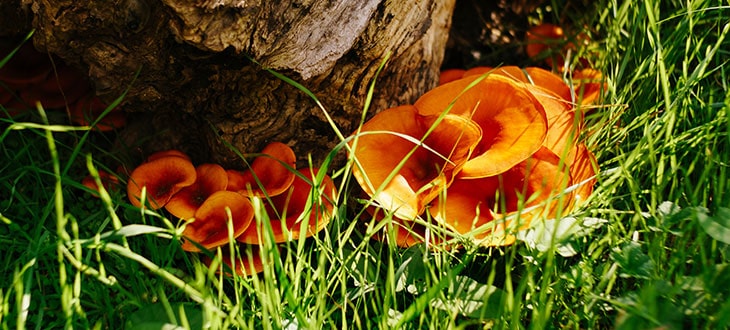10 Orange Mushroom Species
Did you find unknown orange mushrooms in your yard, in the wood, or growing on tree trunks? We made a list of 10 species of orange mushrooms to help you recognize them.
The diversity of mushrooms is impressive. Not only do they look different from species to species, but they also impress with their color variety. We can find species ranging from white to red shades to even green and blue.
In this article, we will talk mainly about several species of fungi that develop predominantly orange fruiting bodies.
Keep in mind that it’s not a good idea to try identifying mushrooms based solely on their colors. Some species may have variable colors depending on the different stages of their lives. Some may be white initially, then turn yellowish, later orange, and even reddish close to the end of their life cycle. Therefore, we recommend you pay great attention when classifying them.
IMPORTANT: The toxicity of each species of mushroom included in this article was obtained from several sources. This data and display photos may or may NOT be entirely accurate. The purpose of this article is NOT to advise whether these species of mushrooms are edible or not, but it’s intended to present fascinating facts about the numerous types of orange fungi.
Never consume any wild mushrooms unless you are 100% sure they are edible! Just because a mushroom species is labeled as “Non-Toxic” or “Non-Poisonous” in this article doesn’t necessarily mean it is edible and safe for consumption.
Contents
- 1. Orange Mycena (Mycena Leaiana)
- 2. Orange Peel Fungus (Aleuria Aurantia)
- 3. Jack-O-Lantern (Omphalotus Illudens)
- 4. Goblet Waxcap (Hygrocybe Cantharellus)
- 5. Lobster Mushroom (Hypomyces Lactifluorum)
- 6. Woolly Chanterelle (Turbinellus Floccosus)
- 7. Jackson’s Slender Amanita (Amanita Jacksonii)
- 8. Eyelash Cup (Scutellinia Scutellata)
- 9. The Orange Bonnet (Mycena Acicula)
- 10. The Golden Trumpet (Xeromphalina Campanella)
1. Orange Mycena (Mycena Leaiana)
| Scientific Name | Mycena leaiana |
| Common Name | The orange mycena, Lea’s mycena |
| Family | Mycenaceae |
| Toxicity | Unknown |
Mycena leaiana is a species of mushrooms with origins in North America, but there is a related variety (Mycena leaiana var. australis) that can be seen in the woodlands of New Zealand and Australia. Other common names for mycena leaiana include the orange mycena or Lea’s mycena.
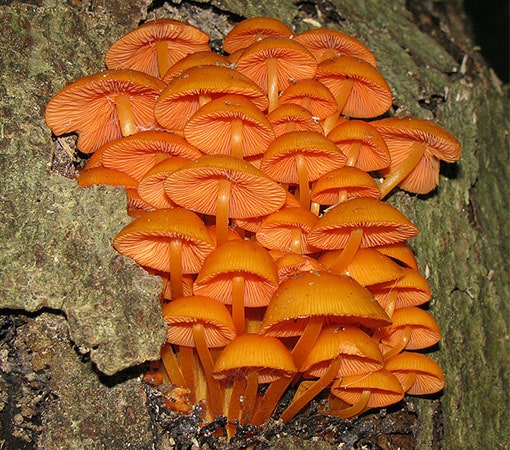
This mushroom species is usually easily distinguished by its bright orange cap with a smooth and sticky surface. Its cap is no greater than 1.5 inches (4 cm) in diameter, has a bright orange color, but this may fade as the mushroom matures. Initially, it has a bell shape but becomes convex with age and frequently forms a depression in the center.
On the underside of the cap, it has crowded orange gills with reddish-orange margins. These are almost free from the stem.
The cap is supported by long and thin stipes, also orange and covered in fine hairs.
Mycena leaiana is a saprobic species. It feeds on dead and rotting wood, leaves, and other organic matter found in the forests. Another particularity of these mushrooms is the fact that they usually grow in dense clusters on deciduous logs.
Although it is oftentimes labeled as non-poisonous, the edibility of Mycena leaiana is unknown. In the absence of any convincing studies concerning these species of mushrooms, it is not recommended their consumption.
2. Orange Peel Fungus (Aleuria Aurantia)
| Scientific Name | Aleuria aurantia |
| Common Name | Orange peel fungus |
| Family | Pyronemataceae |
| Toxicity | Non-Toxic |
Aleuria aurantia is a species of fungus seen throughout Europe, South and North America, parts of Asia, Australia, and New Zealand.
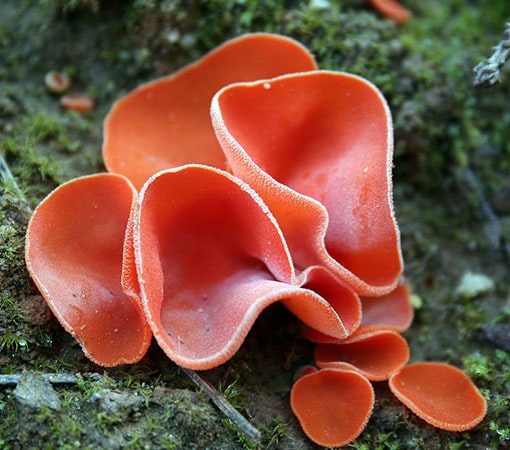
This fungus develops an orange, thin fruiting body similar to a cup, or a husk, hence its popular name, “the orange peel.” When maturing, it can take on a flat or irregular shape and can reach sizes up to 4 inches (10 cm) in diameter under favorable conditions. The underside of the cap may be fuzzy, lighter in color than the top, or even whitish when the mushroom is young.
It doesn’t have a stem. It attaches directly to the ground through a thickening in the center of the cap.
Aleuria aurantia usually appears in late summer to autumn (or even in winter in warmer climates) and grows in clusters on the soil’s surface. It is frequently spotted in urban landscaped areas with disturbed soils, clays, roadside, or covered with wood chip mulches.
Aleuria aurantia is generally considered a non-toxic species and edible if cooked. However, it does not excel in flavor, and many say that it is almost tasteless. It is also quite difficult to pick because it is fragile and breaks into small fragments when touched.
Also keep in mind that there are several poisonous European species that look similar to these mushrooms, such as Caloscypha fulgens or Sarcoscypha coccinea.
3. Jack-O-Lantern (Omphalotus Illudens)
| Scientific Name | Omphalotus illudens |
| Common Name | Jack-O-Lantern Mushroom, The eastern jack-o’lantern mushroom |
| Family | Marasmiaceae |
| Toxicity | Poisonous |
Omphalotus Illudens is a species of orange mushrooms distributed mainly in eastern North America and parts of Europe. These mushrooms are largely known as “jack-o’lantern mushrooms” due to their pumpkin-orange color and bioluminescent properties (thought to glow in the dark due to a chemical reaction, but some say that this is just a myth).
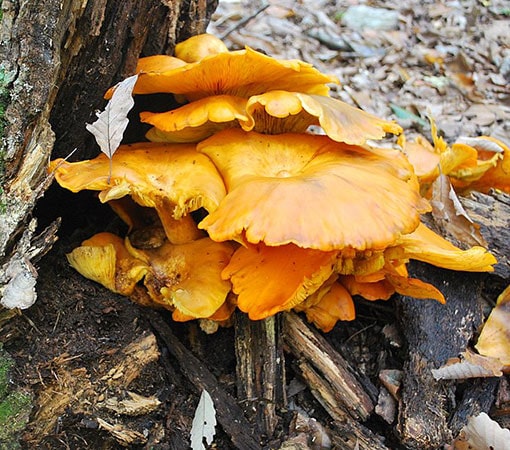
Although luminescence is not very common among mushrooms, according to PlantSnap, there are over 80 species of bioluminescent mushrooms. Through the weak light emitted in the dark, these species of fungi attract certain insects that spread their spores, hence, helping their multiplication.
Omphalotus Illudens is a saprobic fungus that feeds with dead organic matter from the forests, such as decaying stumps or dry fallen branches. It usually grows in clusters and is frequently spotted at the base of hardwood trees.
These fungi can reach fairly large sizes, especially at the group level. They are distinguished by a yellow-to-orange cap that initially has an umbrella shape which later flattens. The underside holds true non-forking gills, the same color as the cap, that run down the stem. The cap’s margins are initially curled inward but later can turn upward.
The stalk is long, has a smooth surface with a bright yellowish-orange color, darkening towards the base.
The Jack-O-Lantern mushrooms are toxic and should never be consumed raw or cooked. Unhappily, they are easily confused with edible species such as the golden chanterelle.
4. Goblet Waxcap (Hygrocybe Cantharellus)
| Scientific Name | Hygrocybe Cantharellus |
| Common Name | Goblet Waxcap |
| Family | Hygrophoraceae |
| Toxicity | Non-Toxic |
Hygrocybe cantharellus is a species of small mushrooms found largely in the grasslands and woodlands of eastern North America, Europe, and parts of Australia. It belongs to the genus Hygrocybe (waxcaps), the family Hygrophoraceae and it’s popularly known as the Goblet Waxcap.
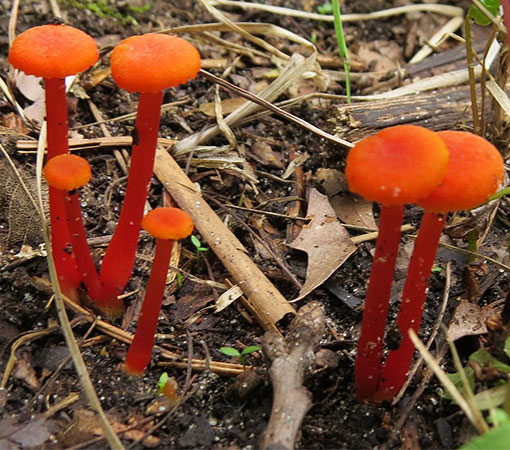
It has a small-size cap with a dry surface whose color can vary from light orange to reddish-orange. It does not usually exceed a few centimeters in width, initially has a convex shape, then flattens out and forms a slight depression in the center.
The cap’s edges are usually twisted inwards, slightly lighter in color, and become scalloped when aging. On the underside, it features sharp-edged pale yellow gills that run down the stem.
The stem is thin but relatively long compared to the mushroom’s size, orange in color, but pales toward the bottom.
Goblet Waxcap is considered by many to be a saprobic fungus because it sometimes grows on wood or decaying roots of plants but also thrives in areas covered with moss. It can grow both in small groups and alone.
Depending on the climate, they usually appear from late summer to late autumn.
Hygrocybe cantharellus is generally considered a non-toxic mushroom, but there is limited data on the edibility of this species to be considered entirely safe for consumption. Its reduced size can also be a downside.
5. Lobster Mushroom (Hypomyces Lactifluorum)
| Scientific Name | Hypomyces Lactifluorum |
| Common Name | Lobster mushroom |
| Family | Hypocreaceae |
| Toxicity | Non-Toxic |
Hypomyces Lactifluorum, or the Lobster mushroom as it’s commonly known, is a species of parasitic fungus that develops on top of several species of mushrooms. Although it is believed to be distributed mainly in North America, there are numerous records of the existence of this fungus on several other continents.
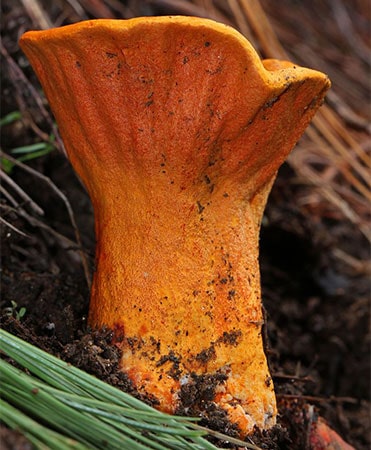
It is popularly called the “lobster mushroom” because it has the appearance of the outer shell of a cooked lobster and a reddish-orange color.
At maturity, hypomyces lactifluorum contains its host entirely, making the original species impossible to identify visually. Studies also point that this fungus not only changes the look of its host but can also alter its chemical composition.
Among the species of mushrooms that Hypomyces Lactifluorum prefers are those of the genus Russula, Lactifluus, and Lactarius.
This fungus is usually found in hardwood and coniferous forests, places where the host mushrooms mentioned above are regularly found.
It doesn’t have always the same shape. While at times mimics the form of the mushroom species it attacks, other times, it can exercise a pretty irregular shape. The orange color and the lobster shell look covered with tiny pimples may be the best indicators to recognize the lobster mushrooms.
Lobster mushrooms are non-toxic and also edible. They are even sold in certain markets. Still, many argue that there may be situations when these parasitic fungi might become inedible.
Although they are known to only parasite particular non-poisonous species, some say that might be always a slim chance for them to infect a poisonous variety. In this case, it raises the possibility to carry on the host’s toxins.
Unfortunately, I was not able to find any solid study to confirm or disprove this fact, nor any reports of poisonings linked to hypomyces lactifluorum consumption. Therefore, I would recommend you to be cautious, and only consume these when you know the host species.
6. Woolly Chanterelle (Turbinellus Floccosus)
| Scientific Name | Hypomyces Lactifluorum |
| Common Name | Woolly chanterelle, Scaly vase, Scaly chanterelle, Shaggy chanterelle |
| Family | Gomphaceae |
| Toxicity | Toxic (may depend on the region) |
Turbinellus floccosus is a species of fungi growing especially in coniferous woodlands across Asia and North America. It has several popular names such as the woolly chanterelle, scaly vase, scaly chanterelle, shaggy chanterelle, and more.
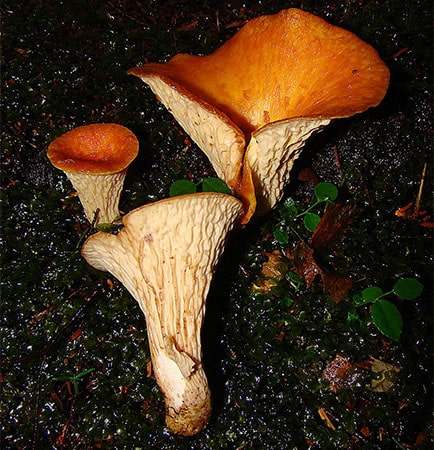
Although the popular name of turbinellus floccosus often includes the term “chanterelle,” and even has some similarities in shape with mushrooms in the genus Cantharellus, they are not related.
Turbinellus floccosus appears especially in late summer and autumn and prefers humid regions with heavy rains. They can grow both individually and in small groups.
These mushrooms are mainly distinguishable through their trumpet or vase-like shape and a central depression that gets deeper when aging. The cap’s top color usually alternates depending on humidity and age and can vary from yellowish orange to a dark reddish-orange.
Instead of gills, turbinellus floccosus possess irregular pale yellow-to-cream wrinkled ridges that go down the whole stem. There is no clear separation between the cap and the stem. Sometimes, multiple fruit bodies may grow from one stipe.
Turbinellus floccosus is generally considered inedible as it is known to cause gastrointestinal problems such as nausea, vomiting, or diarrhea. However, some sources assert that the geographical region in which these mushrooms grow may determine whether or not they are edible. Apparently, those growing in the Pacific Northwest and British Columbia are toxic, while the ones from central Mexico and India are considered edible.
7. Jackson’s Slender Amanita (Amanita Jacksonii)
| Scientific Name | Amanita Jacksonii |
| Common Name | Jackson’s Slender Amanita, American Slender Caesar, Eastern Caesar’s Amanita |
| Family | Amanitaceae |
| Toxicity | Non-Toxic |
Amanita jacksonii is a species of mushrooms native to North America. It belongs to the family Amanitaceae, which is famous for including some of the most poisonous mushrooms, but also varieties appreciated for their flavor.
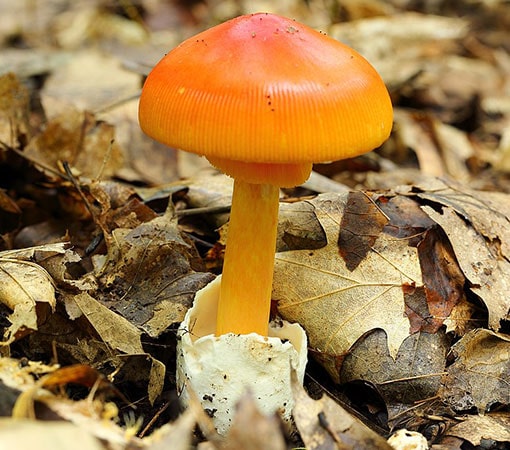
The appearance of this mushroom and its color vary depending on its maturity stage. At first, it looks like a white oval egg that rises above the ground. Later, it opens up, forming an orange or reddish-orange hemispherical cap that becomes convex and eventually flat, usually with a small cavity in the middle.
Its pigment concentrates in a central orange or reddish ring at maturity, fading to yellow toward the margins, with orange streaks on the edges.
The underneath has moderately crowded to crowded yellow to yellow-orange gills, free from the stem or slightly attached. It also presents subtruncate to truncate short gills.
A long and slim yellow stem supports the cap, often sprinkled with orange spots at the surface. At the base, you can often see white remnants of the original coating.
Amanita jacksonii is non-toxic and even labeled as edible by various sources. However, there are several deadly Amanita species similar to them. Hence, there is a significant risk of misidentifying this mushroom and ending up consuming a poisonous one.
8. Eyelash Cup (Scutellinia Scutellata)
| Scientific Name | Scutellinia Scutellata |
| Common Name | Eyelash cup, Molly eye-winker, Common Eyelash Fungus |
| Family | Pyronemataceae |
| Toxicity | Unknown |
Scutellinia scutellata is a saprobic fungus species found in many regions of the world. It is, in fact, one of the most widespread fungi in the world.
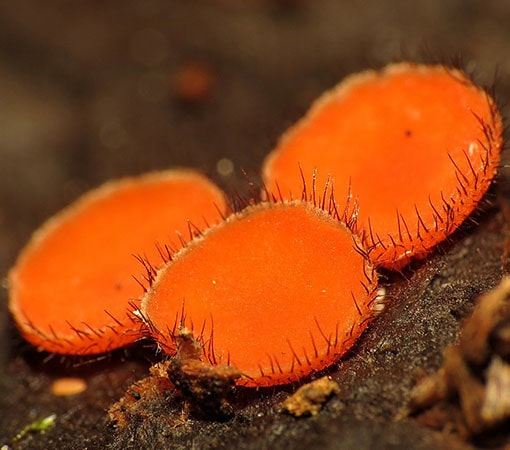
Besides the scientific name, it is also known as the Eyelash cup, Molly eye-winker, or the Common eyelash fungus.
It produces a small fruiting body which is generally seen growing in small groups on rotting wood or on soggy soil. It thrives in swampy environments where there is humidity constantly.
Scutellinia scutellata is easily recognizable due to its oily wet look, bright orange or reddish color, cup shape or flattened, and margins covered with stiff hairs, similar to an eyelash.
Depending on the climate, it can be noticed from late spring to late fall, and sometimes even in winter or spring.
We did not find data regarding the toxicity of Scutellinia scutellata, but most sources seem to indicate that it is not edible.
9. The Orange Bonnet (Mycena Acicula)
| Scientific Name | Scutellinia Scutellata |
| Common Name | The orange bonnet, Coral spring Mycena |
| Family | Mycenaceae |
| Toxicity | Unknown |
Mycena acicula, ordinarily known as the coral spring Mycena or orange bonnet, is a species of miniature mushrooms found throughout Asia, Europe, North America, and the Caribbean.
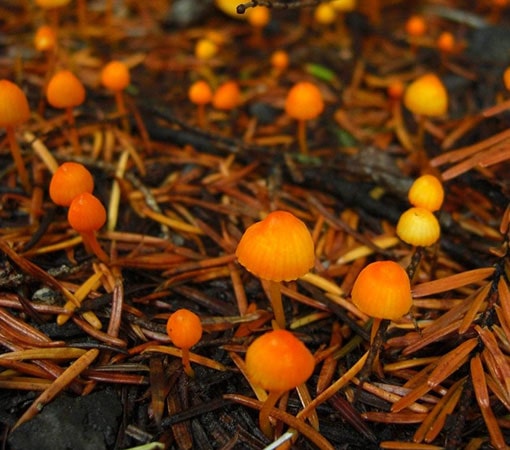
This species of fungus is mainly identified by the small size of its fruiting body, along with several particularities.
The orange bonnet has the classic mushroom look, with an orange-red cap that presents gills underneath and which is supported by a leg. Even at maturity, the cap rarely grows more than 0.4 inches (1cm).
Initially, the cap is hemispherical, later gets a bell shape, and eventually becomes convex. Its surface becomes smooth with the age and shows streaks leading to the edges.
The stem is relatively long compared to the overall size and does not usually exceed 2-2.5 inches (5-6 cm) in length.
These tiny mushrooms grow solitary in wet environments. Are often found on hardwood and conifer twigs or buried under the top layer of the leaf litter. They usually make their presence from late autumn to mid-winter and usually in spring in mountainous regions.
It is not known exactly if these mushrooms contain any toxic chemicals, but they are considered inedible due to their small size.
10. The Golden Trumpet (Xeromphalina Campanella)
| Scientific Name | Scutellinia Scutellata |
| Common Name | The golden trumpet, Bell Omphalina, Fuzzy foot |
| Family | Marasmiaceae |
| Toxicity | Non-Toxic |
Xeromphalina campanella is a saprobic species of mushrooms native to North America. It is known by several names such as the golden trumpet, Omphalina bell, or fuzzy foot.
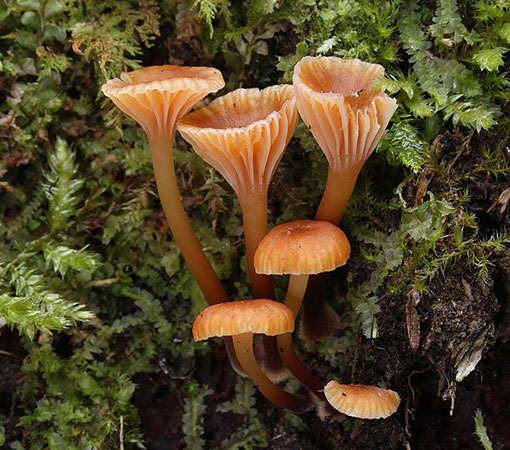
The mushroom is observed in coniferous forests, usually growing in dense clusters on rotting logs and stumps. It is a small mushroom, but it cannot easily go unnoticed due to the fact that it almost always grows in large groups.
The cap of xeromphalina campanella has an umbrella shape when young, then its margins widen and rise, forming a central depression. Its color ranges from brownish yellow to orange. On the underside, it has well-spaced gills that run down the stem. These range in color from pale yellow to orange.
The stalk is thin, light orange near the cap, and brownish to yellow towards the base, which is covered with fine yellow or brown hairs, hence its common name “fuzzy foot.”
Although it is generally considered non-toxic, most sources label Xeromphalina campanella as inedible.
Final Word
This is just a tiny selection of the orange mushrooms that you can observe throughout various regions of the world. Because of their orange color, they are often easily observable in the green grass, growing on trees’ trunks, on decaying wood stumps, on the forest floor, or even in your yard or garden.
We hope you found this list helpful and assist you in identifying mushrooms with this particularity.
Several other species of fungi that produce orange fruiting bodies are:
- Cantharellus cinnabarinus
- Cystodermella cinnabarina
- Entoloma quadratum
- Gliophorus perplexus
- Gymnopilus sapineus
- Gymnosporangium juniperi-virginianae
- Pycnoporellus fulgens
- Pycnoporus cinnabarinus
- Tylopilus balloui
- Laetiporus cincinnatus
Since you have reached the end of the article, you may also be interested in our selection of 10 yellow mushroom species or 10 red mushroom species.
Please do not eat any species of mushrooms based only on the information presented in this article! Always consult a specialist before determining whether a mushroom is safe for consumption or not.

